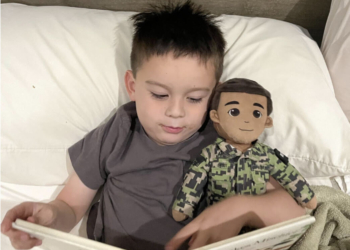Inconsistencies within the nation’s education system are a challenge military families and military kids must frequently navigate with each permanent change of station move.
Stacy Allsbrook-Huisman, an Air Force spouse, writer and advocate within the military spouse community, has navigated three moves and three schools in three years with her two school-aged children. She faced mismatched curriculums and her military kids were not given consistent services for nearly four consecutive years.
“There are more than a million military-connected kids attending public schools, possibly experiencing the same ride on an emotional roller coaster and feeling academically vulnerable like our family did,” Allsbrook-Huisman said. “There had to be a better way for all these amazing, resilient kids to move through transition and I believed empowering their parents with knowledge and practical proven ideas would help.”
Amanda Trimillos has been an Air Force spouse for more than 20 years with four military-connected children, is a National Board Certified Teacher with over 15 years of experience teaching 6th through 12th grades both in her local military community and with the Department of Defense Education Activity overseas. Her dual perspective as both teacher and mother provides a unique insight into the real challenges military students face, and ways parents and teachers can advocate for them.
Allsbrook-Huisman and Trimillos co-authored “Seasons of My Military Student: Practical Ideas for Parents and Teachers.” The book offers teacher tips, parent advice, conversation starters and practical strategies parents and teachers can use on their own and with each other to support the student.
“The best part is that each of the strategies and tips have been used by parents and teachers from all grade levels. They are realistic and vetted by parents and teachers of military-connected students,” Trimillos said.

Allsbrook-Huisman and Trimillos outline military-student transition in “seasons.”
- Season of Leaving: “It begins when there are hints of orders and quiet discussions of where the military may send us next,” Allsbrook-Huisman said.
- Season of Arriving: “This season begins with preparations for the first day at a new school to include registration and meet the teacher,” Allsbrook-Huisman said.
- Season of Growing: “This begins after the first parent-teacher conference and continues as the student begins to put down roots, becoming fully integrated into the new school,” Trimillos said. “This integration period is the time when the student is settling into the new academic standards of the school and state since not all states have the same curriculum or standards.”
- Season of Thriving: “This begins when the student is fully integrated into a new school and continues as long as the student remains at the same school,” Trimillos said.
Trimillos acknowledges inconsistencies between schools as a challenge for military families.
“There are inconsistencies between schools in a single district. And even more when crossing state borders. The average American doesn’t see these inconsistencies because they don’t move as often as military families,” Trimillos said.
She stresses parents be firm yet considerate. “We are coming to the school with experience of frustration behind us. We are ready to battle to ensure our military kids don’t lose academic standing or skills due to a PCS. The school can see the battle in our faces and tone of our voice. But they don’t have the experience to understand our frustration. They need us to be firm while at the same time gentle in our approach. Our children need us to build a partnership with the school.” she said.
To alleviate stress and frustration, Allsbrook-Huisman recommends parents build an education binder with a child’s educational history including work samples, report cards, personal notes about grades and attendance, standardized tests to show progression, list of curricula used by the prior school so teachers and parents can work together to address discrepancies, teacher-to-teacher communication describing the students learning style including strengths and weaknesses, and a picture of the student so a new student doesn’t get lost in the crowd.
Allsbrook-Huisman and Trimillos believe parents and teachers are the boots on the ground for military-connected children, especially when dealing with an Individualized Education Program. Their advice is to follow social media groups, like Facebook, to find special needs groups.
“Make contact with some other parents who are in the same school district. Find out if they have any suggestions on if one school known for being better than another for certain areas of disability. Find someone on the inside,”Allsbrook-Huisman said. Trimillos also reminds parents to be familiar with state and local regulations. The Military Interstate Compact through MIC3 is a great place to start.
Allsbrook-Huisman and Trimillos run a Facebook group, called Seasons of My Military Student Parent & Teacher Group K-12, for parents, teachers and invested adults of military-connected students. Allsbrook-Huisman is also involved with Families on the Home Front, a group helping parents navigate school transition.
“The days of blindly handing our kids over to new schools with hope that they will understand the challenges of military kids are long gone; we need to lean on others who understand our lifestyle for a smoother transition. We are in this together as parents and educators,” Allsbrook-Huisman said.
Read comments






































